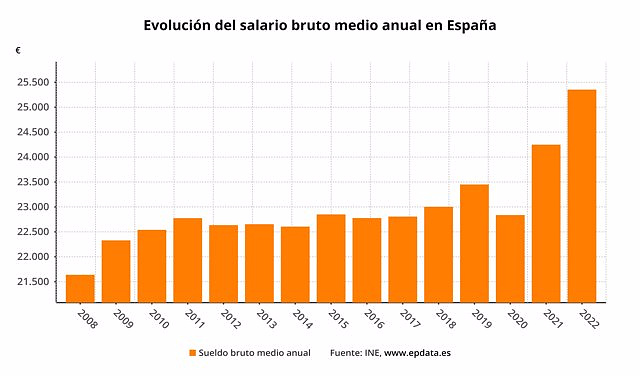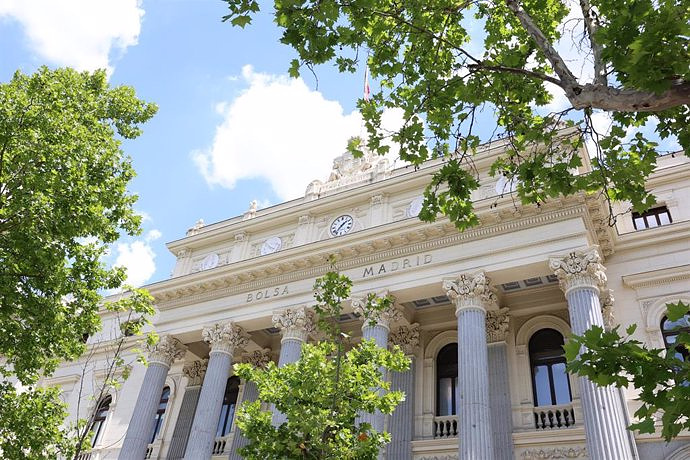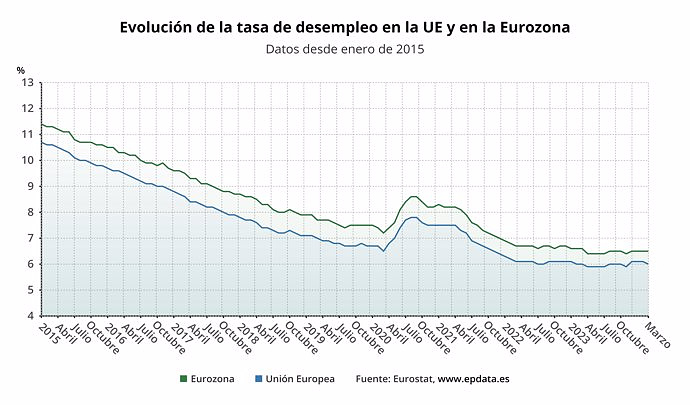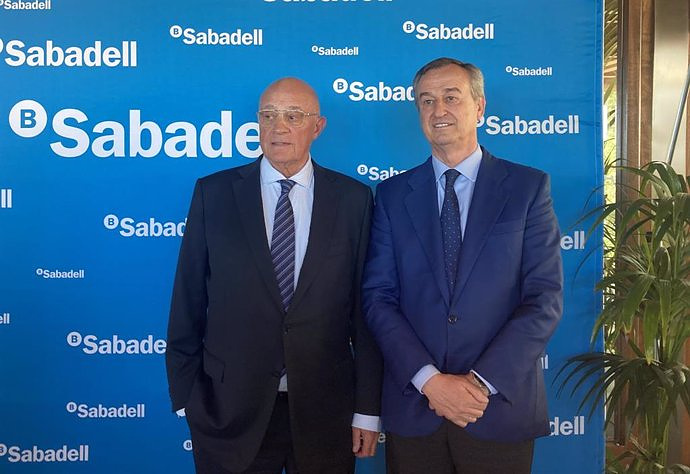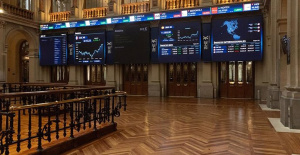95% of the centers, which represent 86.8% of the workers, regulated their labor relations through a collective agreement
MADRID, 21 Jul. (EUROPA PRESS) -
The gross annual salary per worker reached 25,353.22 euros in 2022, which represents an increase of 4.6% compared to the previous year, and stood at its highest level since the beginning of the series, in 2008, according to the results of the Annual Labor Cost Survey (EACL), published this Friday by the National Institute of Statistics (INE).
The INE has explained that this gross annual salary per worker of 25,353.22 euros represented 74% of the total labor cost, while the most important item of non-salary costs were mandatory Social Security contributions (8,055.63 euros per worker), which represented 23.5% of the cost.
In this way, wages and salaries plus Social Security contributions jointly constituted, therefore, 97.4% of the gross cost.
In total, the labor cost per worker in gross terms was 34,286.05 euros in 2022, which represents an increase of 4.2% compared to the previous year. If the subsidies and deductions received from the Public Administrations are subtracted, a net cost of 34,058.83 euros is obtained, with an annual growth of 4.1%.
With the entry into force of Royal Decree-Law 2/2022, of February 22, the ERTE Covid that were in force on February 24 were extended until March 31, 2022. As of that date, only those regulated in articles 47 and 47 bis of the Workers' Statute were maintained. The incidence of this figure during 2022 was very low; In fact, the hours not worked for technical or economic reasons (which include those not worked by ERTE) collected in the survey decreased on average by 91.8% compared to the previous year, according to the INE.
In addition to salaries and contributions, 491.74 euros per year were allocated to social benefits per worker (voluntary contributions to insurance and pension plans, complementary benefits to Social Security and expenses of a social nature), 172.81 euros to other expenses derived from work (indemnities for the end of the contract, small tools and work clothes, transportation to the workplace, personnel selection...), 144.33 euros corresponded to severance payments and 68. 32 euros to professional training.
The differences between the labor cost per worker according to the different activities in the classification were notable, ranging from 20,744.17 gross annual euros per worker in the hospitality industry, to 82,181.05 euros per employee in electricity, gas, steam and air conditioning supply companies.
Regarding the average salary in electricity and gas supply companies, the INE indicates that it stood at 63,074 euros gross per worker in 2022, while in the hospitality industry it was 15,175.7 euros.
In companies linked to financial and insurance activities, the average gross salary was 50,391 euros, while in companies involved in administrative activities and auxiliary services it was 17,336.67 euros.
Considering the differences by territory, the highest labor costs in 2022 occurred in Comunidad de Madrid (40,131.84 euros), the Basque Country (39,624.16) and Catalonia (36,739.55). On the contrary, the lowest were observed in Extremadura (27,430.24 euros), the Canary Islands (28,722.58) and the Region of Murcia (29,961.87).
Considering the variation in labor cost with respect to the previous year, the Canary Islands (10.8%), the Balearic Islands (9.3%) and La Rioja (5.3%) presented the highest rates. Conversely, Region of Murcia (1.2%), the Basque Country (2.5%) and Principado de Asturias (2.6%) registered the smallest increases.
Most of the centers, 95% --corresponding to 86.8% of the workers--, were regulated by collective agreements in 2022, with the area with the highest proportion being less than the state one (autonomous, provincial sectoral agreements, etc.).
Of the total number of workers with an agreement, 3.8% saw their working conditions modified with respect to what was established in the reference collective agreement.
In relation to the cost components, the INE points out that the highest labor cost occurred in those centers regulated by means other than the collective agreement, followed by centers with a company or work center agreement.

 Exploring Cardano: Inner Workings and Advantages of this Cryptocurrency
Exploring Cardano: Inner Workings and Advantages of this Cryptocurrency Seville.- Economy.- Innova.- STSA inaugurates its new painting and sealing hangar in San Pablo, for 18 million
Seville.- Economy.- Innova.- STSA inaugurates its new painting and sealing hangar in San Pablo, for 18 million Innova.- More than 300 volunteers join the Andalucía Compromiso Digital network in one month to facilitate access to ICT
Innova.- More than 300 volunteers join the Andalucía Compromiso Digital network in one month to facilitate access to ICT Innova.-AMP.- Ayesa acquires 51% of Sadiel, which will create new technological engineering products and expand markets
Innova.-AMP.- Ayesa acquires 51% of Sadiel, which will create new technological engineering products and expand markets Cerdán censures the "dirty war" of the right and calls for a debate around "democratic regeneration"
Cerdán censures the "dirty war" of the right and calls for a debate around "democratic regeneration"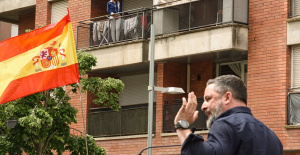 12M.- Abascal (Vox) proposes "massive deportations" in the face of illegal immigration
12M.- Abascal (Vox) proposes "massive deportations" in the face of illegal immigration The campaign reaches the halfway mark marked by Sánchez's reflection and with Illa first in polls
The campaign reaches the halfway mark marked by Sánchez's reflection and with Illa first in polls Iran sends 'Shahid Mahdawi' beyond the equator in first long-distance mission by a warship
Iran sends 'Shahid Mahdawi' beyond the equator in first long-distance mission by a warship How Blockchain in being used to shape the future
How Blockchain in being used to shape the future Not just BTC and ETH: Here Are Some More Interesting Coins Worth Focusing on
Not just BTC and ETH: Here Are Some More Interesting Coins Worth Focusing on A sensor system obtains the fingerprint of essential oils and detects if they have been adulterated
A sensor system obtains the fingerprint of essential oils and detects if they have been adulterated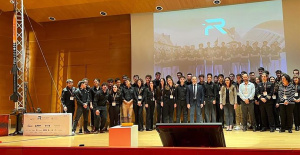 Faraday UPV presents the 'Origin' rocket to exceed 10 km of flight: "It is the beginning of the journey to space"
Faraday UPV presents the 'Origin' rocket to exceed 10 km of flight: "It is the beginning of the journey to space" The Generalitat calls for aid worth 4 million to promote innovation projects in municipalities
The Generalitat calls for aid worth 4 million to promote innovation projects in municipalities UPV students design an app that helps improve the ventilation of homes in the face of high temperatures
UPV students design an app that helps improve the ventilation of homes in the face of high temperatures A million people demonstrate in France against Macron's pension reform
A million people demonstrate in France against Macron's pension reform Russia launches several missiles against "critical infrastructure" in the city of Zaporizhia
Russia launches several missiles against "critical infrastructure" in the city of Zaporizhia A "procession" remembers the dead of the Calabria shipwreck as bodies continue to wash up on the shore
A "procession" remembers the dead of the Calabria shipwreck as bodies continue to wash up on the shore Prison sentences handed down for three prominent Hong Kong pro-democracy activists
Prison sentences handed down for three prominent Hong Kong pro-democracy activists ETH continues to leave trading platforms, Ethereum balance on exchanges lowest in 3 years
ETH continues to leave trading platforms, Ethereum balance on exchanges lowest in 3 years Investors invest $450 million in Consensys, Ethereum incubator now valued at $7 billion
Investors invest $450 million in Consensys, Ethereum incubator now valued at $7 billion Alchemy Integrates Ethereum L2 Product Starknet to Enhance Web3 Scalability at a Price 100x Lower Than L1 Fees
Alchemy Integrates Ethereum L2 Product Starknet to Enhance Web3 Scalability at a Price 100x Lower Than L1 Fees Mining Report: Bitcoin's Electricity Consumption Declines by 25% in Q1 2022
Mining Report: Bitcoin's Electricity Consumption Declines by 25% in Q1 2022 Oil-to-Bitcoin Mining Firm Crusoe Energy Systems Raised $505 Million
Oil-to-Bitcoin Mining Firm Crusoe Energy Systems Raised $505 Million Microbt reveals the latest Bitcoin mining rigs -- Machines produce up to 126 TH/s with custom 5nm chip design
Microbt reveals the latest Bitcoin mining rigs -- Machines produce up to 126 TH/s with custom 5nm chip design Bitcoin's Mining Difficulty Hits a Lifetime High, With More Than 90% of BTC Supply Issued
Bitcoin's Mining Difficulty Hits a Lifetime High, With More Than 90% of BTC Supply Issued The Biggest Movers are Near, EOS, and RUNE during Friday's Selloff
The Biggest Movers are Near, EOS, and RUNE during Friday's Selloff Global Markets Spooked by a Hawkish Fed and Covid, Stocks and Crypto Gain After Musk Buys Twitter
Global Markets Spooked by a Hawkish Fed and Covid, Stocks and Crypto Gain After Musk Buys Twitter Bitso to offset carbon emissions from the Trading Platform's ERC20, ETH, and BTC Transactions
Bitso to offset carbon emissions from the Trading Platform's ERC20, ETH, and BTC Transactions Draftkings Announces 2022 College Hoops NFT Selection for March Madness
Draftkings Announces 2022 College Hoops NFT Selection for March Madness